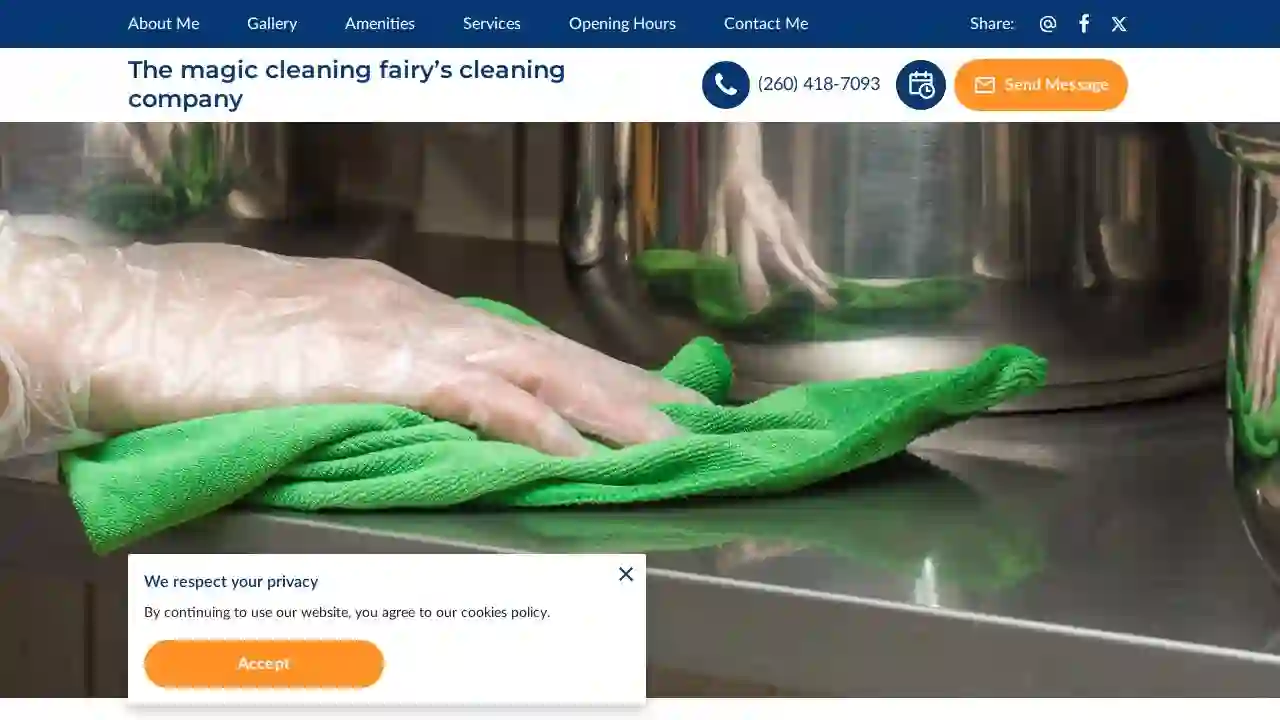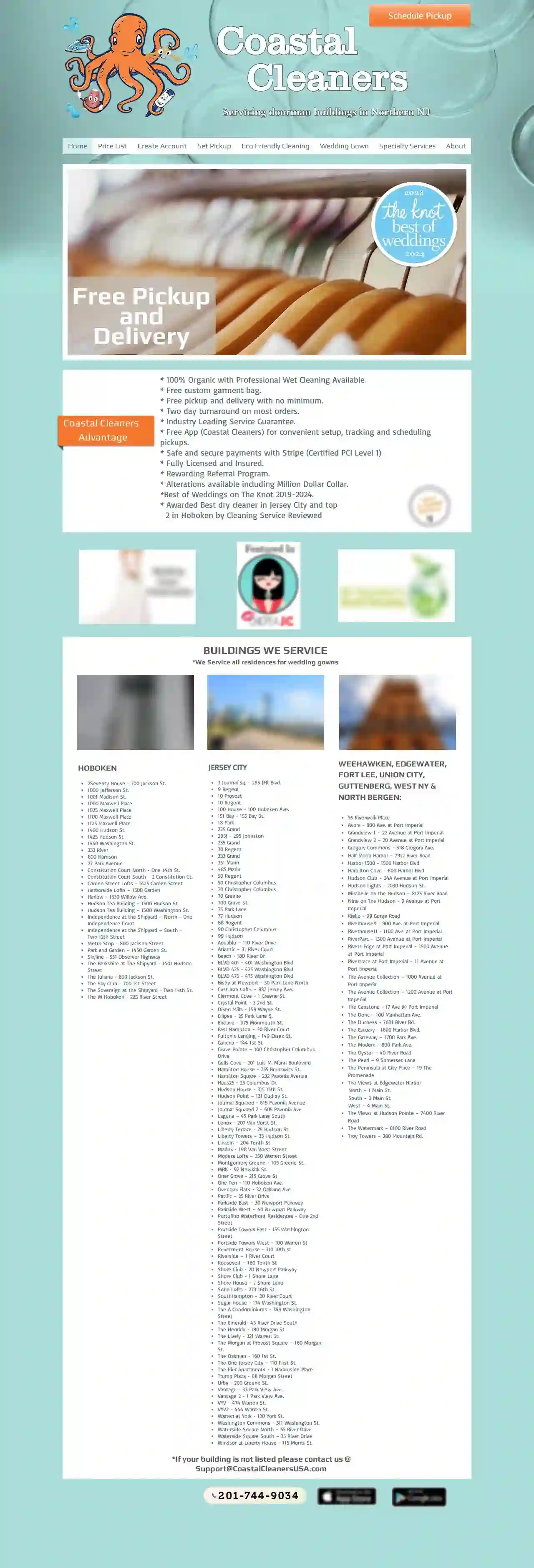Cleaning Services Holland
Top Cleaning Companies in Holland
Receive 3 FREE Residential Cleaning quotes for your project today! Compare profiles, reviews, accreditations, portfolio, etc... and choose the best service.

The magic cleaning fairy’s cleaning company
Fort Wayne, USAt The Magic Cleaning Fairy's Cleaning Company, we take the hassle out of cleaning. No matter the size of your home, our trained domestic cleaners work to the highest standard and will leave it sparkling. Located in Fort Wayne, we also offer a range of specialist cleaning services, including end of tenancy cleaning, after party cleaning, and carpet cleaning. Call us today on +1 260 418 7093 to discuss your cleaning requirements. Ready for some shine? Our specialist team of trained cleaners are ready at short notice, to visit your property and address your cleaning requirements. We pride ourselves on using industry-leading products and techniques to leave your home or office sparkling. Whether you're seeking end of tenancy cleaning or after party cleaning, we guarantee a rapid and efficient service, leaving you free to do other things. Take a look at our list of cleaning solutions now and choose the right option for your property.
- Services
- Why Us?
Get Quote
Cleaning Services
4.824 reviewsWayne, US- Services
- Why Us?
- Gallery
Get Quote
Coastal Cleaners - Pickup and Delivery
4.7156 reviewsJersey City, US- Services
- Why Us?
- Gallery
Get Quote
Sparkle Custom Cleaning, LLC
511 reviews581 Rosemar Drive, Morrisville, 19067, USWelcome to Sparkle Custom Cleaning, LLC, your trusted partner for all your commercial and residential cleaning needs. With over a decade of experience, our team is dedicated to providing top-notch cleaning services that sparkle with professionalism and care. Our founder, Jessica Sanko, has been passionate about cleaning and organizing apartments and houses, initially starting with friends and family. After over five years of unwavering commitment and hard work, she decided to take the leap of faith and embark on her journey as the owner of Sparkle Custom Cleaning, LLC. At Sparkle Custom Cleaning, LLC, we are committed to using environmentally-friendly cleaning products and methods. We believe in doing our part to protect the planet and reduce our carbon footprint. Our team is made up of dedicated professionals who are committed to providing exceptional cleaning services. We carefully select our staff to ensure that they are not only experienced but also share our passion for creating a clean and healthy environment.
- Services
- Why Us?
- Accreditations
- Our Team
- Testimonials
- Gallery
Get Quote
Excel Cleaning Group LLC
4.953 reviewsJersey City, US- Services
- Why Us?
- Gallery
Get Quote
JH22 Cleaning Services
516 reviewsJackson, USPremium Cleaning Services in Jackson Hole JH22, LLC is a professional property service company catering specifically to residential cleaning, commercial cleaning and various home improvement services. Our mission is simple; to provide top quality, eco-friendly & cost effective home services consistently. Long term business is what we strive for.
- Services
- Why Us?
- Testimonials
- Gallery
Get Quote- Sh
Shore Natural Cleaning Services
511 reviewsAtlantic City, US- Services
- Why Us?
Get Quote 
RMS Janitorial Services LLC
4.73 reviewsTrenton, US- Services
- Why Us?
- Gallery
Get Quote- Be
Bea's Home Services LLC
4.815 reviewsTrenton, US- Services
- Why Us?
Get Quote - DD
DD&C Cleaning Service LLC
55 reviewsJersey City, US- Services
- Why Us?
Get Quote
Over 60,241+ Janitorial Contractors on our directory
Our cleaning companies operate in Holland and surroundings!
CleaningMatch has curated and vetted Top Cleaning Companies in and around Holland. Find a reliable contractor today.
Frequently Asked Questions About Cleaning Services
- Declutter Regularly: Set aside time regularly to declutter your belongings. Donate, sell, or discard items you no longer use or need.
- Designated Storage: Assign specific storage spaces for different items, such as shelves for books, drawers for clothes, and containers for toys.
- Labeling: Label storage containers and drawers to make it easy to find items and put them back in their designated places.
- 'One In, One Out' Rule: For every new item you bring into your home, get rid of an old one. This prevents clutter from accumulating.
- Vertical Storage: Utilize vertical storage solutions, such as shelves, wall organizers, and hanging racks, to maximize space.
- Digital Organization: Organize digital files and emails to reduce paper clutter. Use cloud storage services to free up space on your computer.
- Ventilation: Improve ventilation by opening windows, turning on the exhaust fan, and using a dehumidifier to reduce moisture levels.
- Bleach Solution: Mix one cup of bleach with one gallon of water. Wear gloves and eye protection when handling bleach. Apply the solution to the affected area, let it sit for 10-15 minutes, then scrub with a brush and rinse thoroughly.
- Vinegar Solution: For a milder alternative, mix equal parts water and vinegar. Apply to the moldy area, let it sit for an hour, then scrub and rinse.
- Baking Soda Paste: Make a paste of baking soda and water, apply to the moldy area, let it dry, then scrub and rinse. Baking soda helps remove stains and deodorize.
- Commercial Mold and Mildew Remover: Use a commercial mold and mildew remover according to the product instructions.
- Cleaning: Removing dirt, dust, and debris from surfaces using soap or detergent and water. It improves the appearance and removes visible contaminants.
- Sanitizing: Reducing the number of bacteria on surfaces to a safe level. It uses chemical disinfectants or heat to kill or inactivate bacteria.
- Disinfecting: Killing or inactivating most disease-causing microorganisms on surfaces. It uses stronger chemical disinfectants than sanitizing and targets a wider range of pathogens.
- Experience and a proven track record: Choose companies with a solid history of providing quality cleaning services.
- Positive customer reviews and testimonials: Check online reviews and ratings to gauge customer satisfaction.
- Licensed and insured professionals: Ensure the company has the necessary licenses and insurance to protect you from liability.
- Clear and transparent pricing: Obtain detailed quotes and compare prices from multiple companies.
- Good communication and responsiveness: Choose a company that communicates clearly, responds promptly, and addresses your concerns.
What are some tips for keeping my home organized and clutter-free?
By adopting these strategies, you can create a more organized and clutter-free home, promoting a sense of calm and efficiency.
How do I remove mold and mildew from my bathroom?
Always test any cleaning solution on a small, inconspicuous area first. After cleaning, take steps to prevent future mold growth by addressing moisture issues, such as fixing leaks and improving ventilation.
What is the difference between cleaning, sanitizing, and disinfecting?
Cleaning is usually the first step, followed by sanitizing or disinfecting depending on the level of hygiene required.
How do I find a good cleaning service?
Utilize online directories like CleaningMatch to find and compare qualified cleaning services in your area.
What are some tips for keeping my home organized and clutter-free?
- Declutter Regularly: Set aside time regularly to declutter your belongings. Donate, sell, or discard items you no longer use or need.
- Designated Storage: Assign specific storage spaces for different items, such as shelves for books, drawers for clothes, and containers for toys.
- Labeling: Label storage containers and drawers to make it easy to find items and put them back in their designated places.
- 'One In, One Out' Rule: For every new item you bring into your home, get rid of an old one. This prevents clutter from accumulating.
- Vertical Storage: Utilize vertical storage solutions, such as shelves, wall organizers, and hanging racks, to maximize space.
- Digital Organization: Organize digital files and emails to reduce paper clutter. Use cloud storage services to free up space on your computer.
By adopting these strategies, you can create a more organized and clutter-free home, promoting a sense of calm and efficiency.
How do I remove mold and mildew from my bathroom?
- Ventilation: Improve ventilation by opening windows, turning on the exhaust fan, and using a dehumidifier to reduce moisture levels.
- Bleach Solution: Mix one cup of bleach with one gallon of water. Wear gloves and eye protection when handling bleach. Apply the solution to the affected area, let it sit for 10-15 minutes, then scrub with a brush and rinse thoroughly.
- Vinegar Solution: For a milder alternative, mix equal parts water and vinegar. Apply to the moldy area, let it sit for an hour, then scrub and rinse.
- Baking Soda Paste: Make a paste of baking soda and water, apply to the moldy area, let it dry, then scrub and rinse. Baking soda helps remove stains and deodorize.
- Commercial Mold and Mildew Remover: Use a commercial mold and mildew remover according to the product instructions.
Always test any cleaning solution on a small, inconspicuous area first. After cleaning, take steps to prevent future mold growth by addressing moisture issues, such as fixing leaks and improving ventilation.
What is the difference between cleaning, sanitizing, and disinfecting?
- Cleaning: Removing dirt, dust, and debris from surfaces using soap or detergent and water. It improves the appearance and removes visible contaminants.
- Sanitizing: Reducing the number of bacteria on surfaces to a safe level. It uses chemical disinfectants or heat to kill or inactivate bacteria.
- Disinfecting: Killing or inactivating most disease-causing microorganisms on surfaces. It uses stronger chemical disinfectants than sanitizing and targets a wider range of pathogens.
Cleaning is usually the first step, followed by sanitizing or disinfecting depending on the level of hygiene required.
How do I find a good cleaning service?
- Experience and a proven track record: Choose companies with a solid history of providing quality cleaning services.
- Positive customer reviews and testimonials: Check online reviews and ratings to gauge customer satisfaction.
- Licensed and insured professionals: Ensure the company has the necessary licenses and insurance to protect you from liability.
- Clear and transparent pricing: Obtain detailed quotes and compare prices from multiple companies.
- Good communication and responsiveness: Choose a company that communicates clearly, responds promptly, and addresses your concerns.
Utilize online directories like CleaningMatch to find and compare qualified cleaning services in your area.